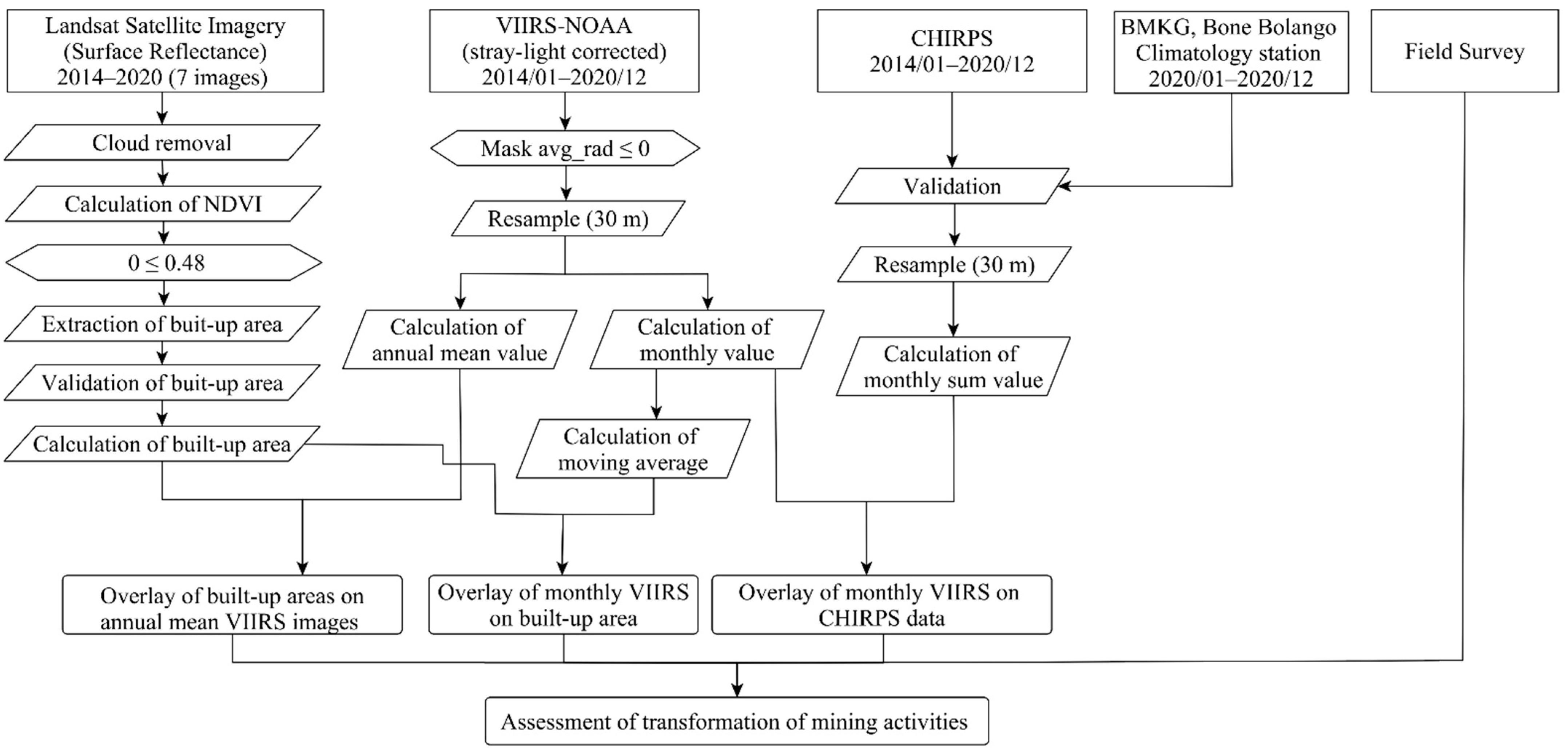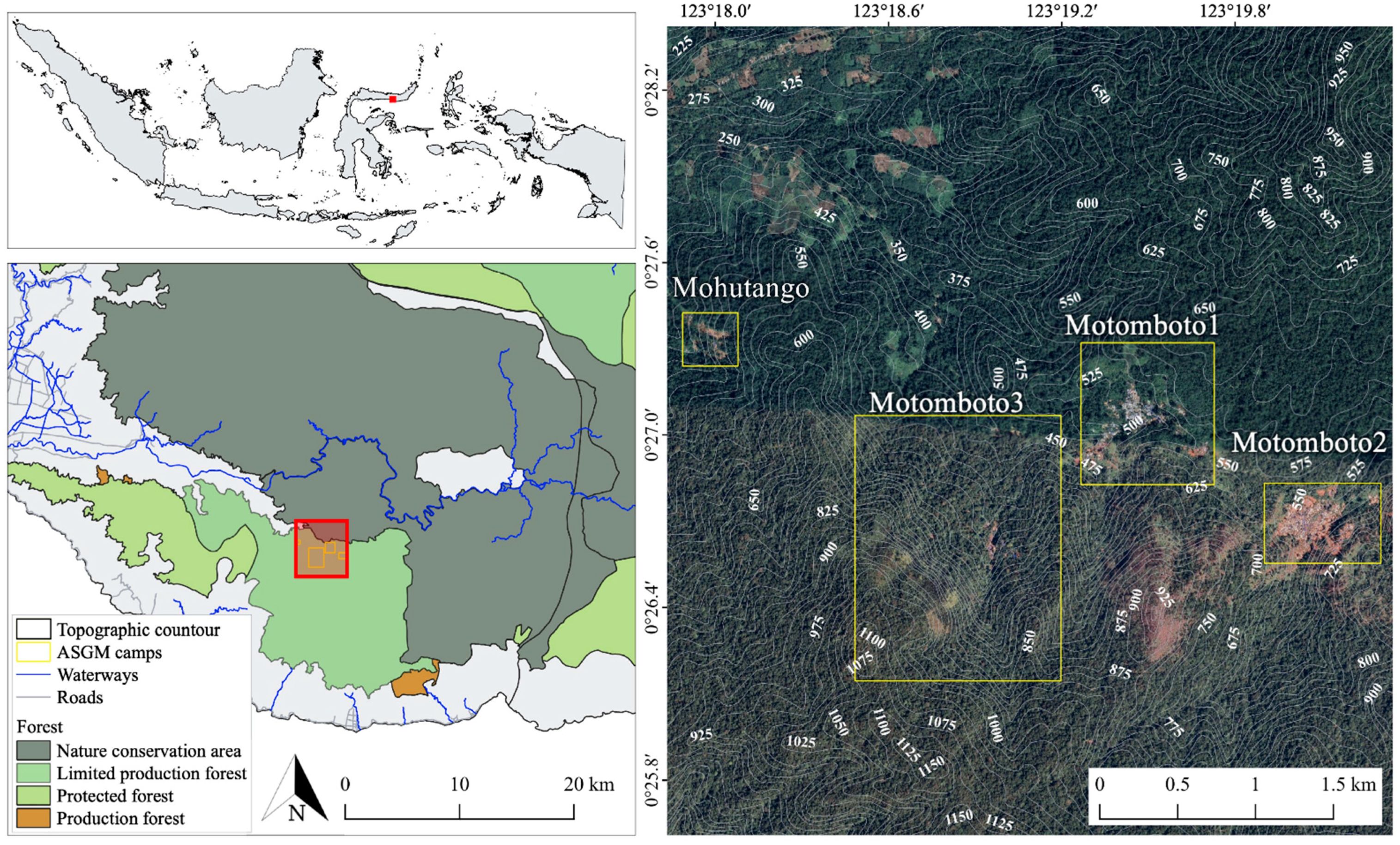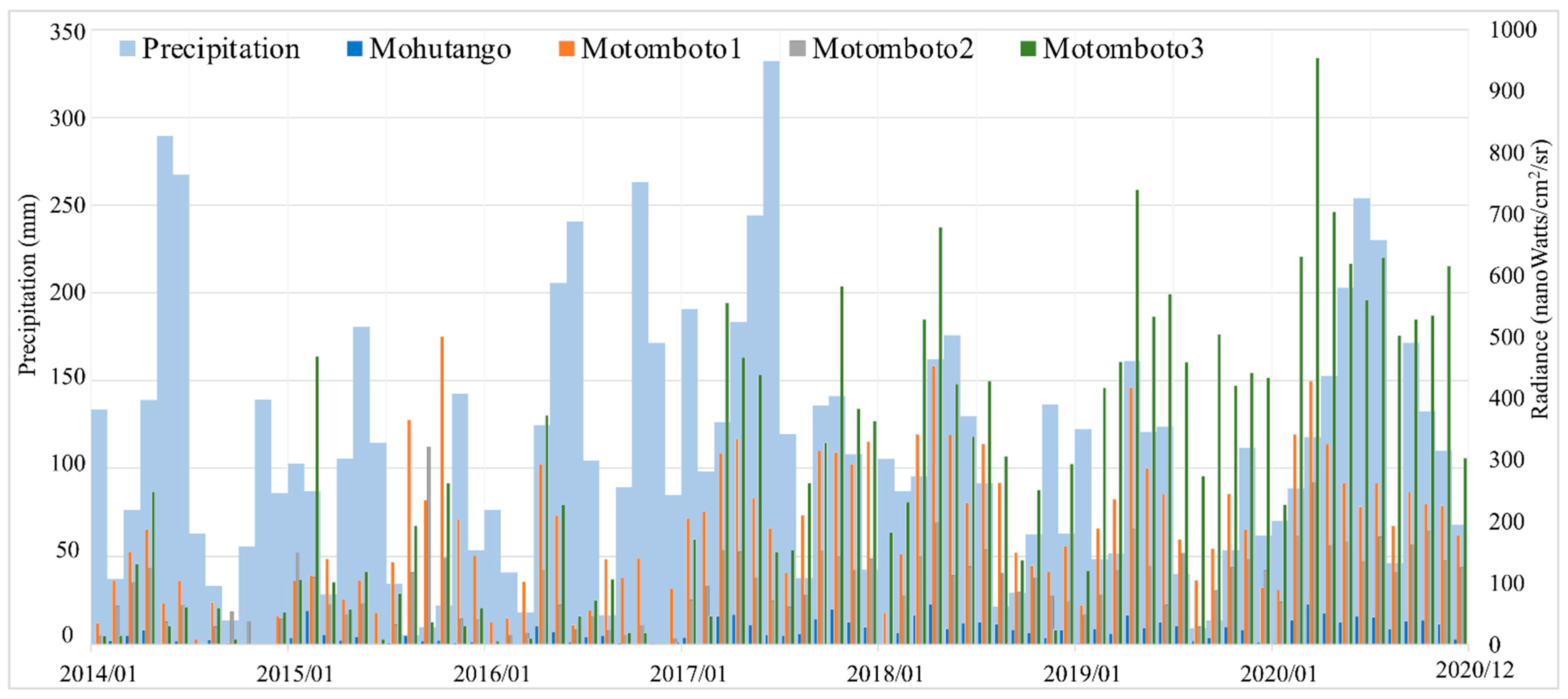Detection of Artisanal and Small-Scale Gold Mining Activities and Their Transformation Using Earth Observation, Nighttime Light, and Precipitation Data
Abstract
1. Introduction
2. Materials and Methods
2.1. Overall Methodological Workflow
2.2. Study Area
2.3. Satellite Imagery
2.4. Extraction of Built-Up Areas, NTL, and Precipitation Data
2.5. Investigation of ASGM Camps
3. Results
3.1. Growth of Built-Up Areas in the Mining Camps
3.2. Relationship between Built-Up Areas and NTL Intensity in the Mining Camps
3.3. Relationship between the NLT Intensity and Precipitation by Month
4. Discussion and Limitations
4.1. Discussion
4.2. Limitations
5. Conclusions
Author Contributions
Funding
Institutional Review Board Statement
Informed Consent Statement
Data Availability Statement
Acknowledgments
Conflicts of Interest
References
- De Lobo, F.L.; Costa, M.; de Novo, E.M.L.M.; Telmer, K. Distribution of Artisanal and Small-Scale Gold Mining in the Tapajós River Basin (Brazilian Amazon) over the Past 40 Years and Relationship with Water Siltation. Remote Sens. 2016, 8, 579. [Google Scholar] [CrossRef]
- International Institute for Sustainable Development. Global Trends in Artisanal and Small-Scale Mining (Asm): A Review of Key Numbers and Issues; International Institute for Sustainable Development: Winnipeg, MB, Canada, 2018. [Google Scholar]
- United Nations Environment Programme. Estimating Mercury Use and Documenting Practices in Artisanal and Small-scale Gold Mining (ASGM); International Institute for Sustainable Development: Geneva, Switzerland, 2017. [Google Scholar]
- World Health Organization. Artisanal and Small-Scale Gold Mining and Health; World Health Organization: Geneva, Switzerland, 2016. [Google Scholar]
- United Nations Environment Programmet. Technical Background Report to the Global Mercury Assessment 2018; United Nations Environment Programmet: Tromsø, Norway, 2018. [Google Scholar]
- Saldarriaga-Isaza, A.; Villegas-Palacio, C.; Arango, S. The public good dilemma of a non-renewable common resource: A look at the facts of artisanal gold mining. Resour. Policy 2013, 38, 224–232. [Google Scholar] [CrossRef]
- United Nations Environment Programme. Global Mercury Assessment 2018; United Nations Environment Programme: Geneva, Switzerland, 2018. [Google Scholar]
- Macháček, J. Typology of environmental impacts of artisanal and small-scale mining in African Great Lakes Region. Sustainability 2019, 11, 3027. [Google Scholar] [CrossRef]
- Wilson, M.L.; Renne, E.; Roncoli, C.; Agyei-Baffour, P.; Tenkorang, E.Y. Integrated assessment of artisanal and small-scale gold mining in Ghana—Part 3: Social sciences and economics. Int. J. Environ. Res. Public Health 2015, 12, 8133–8156. [Google Scholar] [CrossRef] [PubMed]
- BaliFokus Foundation. Mercury Country Situation Report Indonesia; BaliFokus Foundation: Bli, Indonesia, 2018. [Google Scholar]
- Agrawal, A.W.; Anthony, S.; Bebbington, J.; Imhof, A.; Jebing, M.; Royo, N.; Sauls, L.A.; Sulaiman, R.; Toumbourou, T. Impacts of Extractive Industry and Infrastructure on Forests: Indonesia; Climate and Land Use Allaince: San Francisco, CA, USA, 2018. [Google Scholar]
- Statistics of Bone Bolango Regency. Bone Bolango Dalam Angka 2010; BPS-Statistics of Bone Bolango Regency: Suwawa, Indonesia, 2010. [Google Scholar]
- Kimijima, S.; Sakakibara, M.; Nagai, M.; Gafur, N.A. Time-series Assessment of Camp-type Artisanal and Small-scale Gold Mining Sector with Large Influxes of Miners using LANDSAT Imagery. Int. J. Environ. Res. Public Health 2021, 18, 9441. [Google Scholar] [CrossRef] [PubMed]
- GoldPrice.Org. Gold Price in USD. 2021. Available online: https://goldprice.org/spot-gold.html (accessed on 19 July 2021).
- Asner, G.P.; Llactayo, W.; Tupayachi, R.; Luna, E.R. Elevated rates of gold mining in the Amazon revealed through high-resolution monitoring. Proc. Natl. Acad. Sci. USA 2013, 110, 18454–18459. [Google Scholar] [CrossRef]
- Swenson, J.J.; Carter, C.E.; Domec, J.C.; Delgado, C.I. Gold mining in the peruvian amazon: Global prices, deforestation, and mercury imports. PLoS ONE 2011, 6, e18875. [Google Scholar] [CrossRef]
- Macháček, J. Alluvial artisanal and small-scale mining in a river stream-Rutsiro case study (Rwanda). Forests 2020, 11, 762. [Google Scholar] [CrossRef]
- Kahhat, R.; Parodi, E.; Larrea-Gallegos, G.; Mesta, C.; Vázquez-Rowe, I. Environmental impacts of the life cycle of alluvial gold mining in the Peruvian Amazon rainforest. Sci. Total Environ. 2019, 662, 940–951. [Google Scholar] [CrossRef]
- Nakazawa, K.; Nagafuchi, O.; Kawakami, T.; Inoue, T.; Yokota, K.; Serikawa, Y.; Basir-Cyio, M.; Elvince, R. Human health risk assessment of mercury vapor around artisanal small-scale gold mining area, Palu city, Central Sulawesi, Indonesia. Ecotoxicol. Environ. Saf. 2016, 124, 155–162. [Google Scholar] [CrossRef] [PubMed]
- Bose-O’Reilly, S.; Drasch, G.; Beinhoff, C.; Rodrigues-Filho, S.; Roider, G.; Lettmeier, B.; Maydl, A.; Maydl, S.; Siebert, U. Health assessment of artisanal gold miners in Indonesia. Sci. Total Environ. 2009, 408, 713–725. [Google Scholar] [CrossRef]
- Wyatt, L.; Ortiz, E.J.; Feingold, B.; Berky, A.; Diringer, S.; Morales, A.M.; Jurado, E.R.; Hsu-Kim, H.; Pan, W. Spatial, Temporal, and Dietary Variables Associated with Elevated Mercury Exposure in Peruvian Riverine Communities Upstream and Downstream of Artisanal and Small-Scale Gold Mining. Int. J. Environ. Res. Public Health 2017, 14, 1582. [Google Scholar] [CrossRef] [PubMed]
- Schmid, T.; Rico, C.; Rodríguez-Rastrero, M.; José Sierra, M.; Javier Díaz-Puente, F.; Pelayo, M.; Millán, R. Monitoring of the mercury mining site Almadén implementing remote sensing technologies. Environ. Res. 2013, 125, 92–102. [Google Scholar] [CrossRef]
- Espejo, J.C.; Messinger, M.; Román-Dañobeytia, F.; Ascorra, C.; Fernandez, L.E.; Silman, M. Deforestation and forest degradation due to gold mining in the Peruvian Amazon: A 34-year perspective. Remote Sens. 2018, 10, 1–17. [Google Scholar] [CrossRef]
- Emel, J.; Plisinski, J.; Rogan, J. Monitoring geomorphic and hydrologic change at mine sites using satellite imagery: The Geita Gold Mine in Tanzania. Appl. Geogr. 2014, 54, 243–249. [Google Scholar] [CrossRef]
- Owusu-Nimo, F.; Mantey, J.; Nyarko, K.B.; Appiah-Effah, E.; Aubynn, A. Spatial distribution patterns of illegal artisanal small scale gold mining (Galamsey) operations in Ghana: A focus on the Western Region. Heliyon 2018, 4, e00534. [Google Scholar] [CrossRef] [PubMed]
- Puluhulawa, F.; Harun, A.A. Policy formalization of Artisanal and Small-Scale Gold Mining (ASGM) post-ratification of Minamata Convention for Sustainability (case study of ASGM Gorontalo). E3S Web Conf. 2019, 125, 02006. [Google Scholar] [CrossRef]
- Gallwey, J.; Robiati, C.; Coggan, J.; Vogt, D.; Eyre, M. A Sentinel-2 based multispectral convolutional neural network for detecting artisanal small-scale mining in Ghana: Applying deep learning to shallow mining. Remote Sens. Environ. 2020, 248, 111970. [Google Scholar] [CrossRef]
- Chen, X.; Nordhaus, W. A test of the new VIIRS lights data set: Population and economic output in Africa. Remote Sens. 2015, 7, 4937–4947. [Google Scholar] [CrossRef]
- PT Bumi Resources Minerals Tbk. Laporan Tahunan 2019 Annual Report; PT Bumi Resources Minerals Tbk: Jakarta, Indonesia, 2019. [Google Scholar]
- Van Bemmelen, R.W. The Geology of Indonesia. General Geology of Indonesia and Adjacent Archipelagoes. Gov. Print. Off. Hague 1949, 545–547, 561–562. [Google Scholar]
- Kesatuan Pengelotaan Hutan. Rencana Pengelolaan Hutan Jangka Panjang Kphp Unit Vii Bone Bolango Tahun 2016–2025; Bone Bolango Regency: Suwawa, Indonesia, 2016. [Google Scholar]
- Hatu, R.A. Socio-economic conditions in the illegal gold miners Tulabolo Village, Gorontalo-in Indonesian. Asian J. Appl. Sci. 2016, 9, 97–105. [Google Scholar] [CrossRef][Green Version]
- Kimijima, S.; Nagai, M. Human mobility analysis for extracting local interactions under rapid socio-economic transformation in Dawei, Myanmar. Sustainability 2017, 9, 1598. [Google Scholar] [CrossRef]
- Kawamura, M.; Jayamana, S.; Tsujiko, Y. Relation between social and environmental conditions in colombo sri lanka and the urban index estimated by satellite remote sensing data. Int. Arch. Photogramm. Remote Sens. 1996, 31, 321–326. [Google Scholar]
- Zha, Y.; Gao, J.; Ni, S. Use of normalized difference built-up index in automatically mapping urban areas from TM imagery. Int. J. Remote Sens. 2003, 24, 583–594. [Google Scholar] [CrossRef]
- Xu, H. A new index for delineating built-up land features in satellite imagery. Int. J. Remote Sens. 2008, 29, 4269–4276. [Google Scholar] [CrossRef]
- Bhatti, S.S.; Tripathi, N.K. Built-up area extraction using Landsat 8 OLI imagery. GIScience Remote Sens. 2014, 51, 445–467. [Google Scholar] [CrossRef]
- As-syakur, A.R.; Adnyana, I.W.S.; Arthana, I.W.; Nuarsa, I.W. Enhanced built-UP and bareness index (EBBI) for mapping built-UP and bare land in an urban area. Remote Sens. 2012, 4, 2957–2970. [Google Scholar] [CrossRef]
- Waqar, M.M.; Mirza, J.F.; Mumtaz, R.; Hussain, E. Development of New Indices for Extraction of Built-Up Area & Bare Soil. Open Access Sci. Reports 2012, 1, 1–4. [Google Scholar]
- Kaimaris, D.; Patias, P. Identification and Area Measurement of the Built-Up Area with the Built-Up Index (bui). Available online: https://www.semanticscholar.org/paper/Identification-and-Area-Measurement-of-the-Built-up-Kaimaris-Patias/8af141e5f616488d238384111b69137bb54b1ec9 (accessed on 1 August 2021).
- Firozjaei, M.K.; Sedighi, A.; Kiavarz, M.; Qureshi, S.; Haase, D.; Alavipanah, S.K. Automated built-up extraction index: A new technique for mapping surface built-up areas using LANDSAT 8 OLI imagery. Remote Sens. 2019, 11, 1966. [Google Scholar] [CrossRef]
- Villa, P.; Mousivand, A.; Bresciani, M. Aquatic vegetation indices assessment through radiative transfer modeling and linear mixture simulation. Int. J. Appl. Earth Obs. Geoinf. 2014, 30, 113–127. [Google Scholar] [CrossRef]
- Zhou, G.; Ma, Z.; Sathyendranath, S.; Platt, T.; Jiang, C.; Sun, K. Canopy reflectance modeling of aquatic vegetation for algorithm development: Global sensitivity analysis. Remote Sens. 2018, 10, 837. [Google Scholar] [CrossRef]
- Jaskuła, J.; Sojka, M. Assessing spectral indices for detecting vegetative overgrowth of reservoirs. Polish J. Environ. Stud. 2019, 28, 4199–4211. [Google Scholar] [CrossRef]
- Villa, P.; Bresciani, M.; Braga, F.; Bolpagni, R. Comparative Assessment of Broadband Vegetation Indices Over Aquatic Vegetation. IEEE J. Sel. Top. Appl. Earth Obs. Remote Sens. 2014, 7, 3117–3127. [Google Scholar] [CrossRef]
- Pericak, A.A.; Thomas, C.J.; Kroodsma, D.A.; Wasson, M.F.; Ross, M.R.V.; Clinton, N.E.; Campagna, D.J.; Franklin, Y.; Bernhardt, E.S.; Amos, J.F. Mapping the yearly extent of surface coal mining in central appalachia using landsat and google earth engine. PLoS ONE 2018, 13, 1–15. [Google Scholar] [CrossRef]
- Japan Association on Remote Sensing. Remote Sensing Note; Japan Association on Remote Sensing: Tokyo, Japan, 1993. [Google Scholar]
- Jeswani, R.; Anurag, K.; Gupta, P.K.; Srivastav, S.K. Evaluation of the consistency of DMSP-OLS and SNPP-VIIRS night-time light datasets Reshma. J. Geomatics 2019, 13, 98–105. [Google Scholar]
- Indonesian Agency for Meteorology Climatology and Geophysics. Daily Data of Bone Bolango Climatology Station. 2021. Available online: https://dataonline.bmkg.go.id/ (accessed on 10 October 2021).
- Sousa, R.N.; Veiga, M.M.; Meech, J.; Jokinen, J.; Sousa, A.J. A simpli fi ed matrix of environmental impacts to support an intervention program in a small-scale mining site. J. Clean. Prod. 2011, 19, 580–587. [Google Scholar] [CrossRef]
- Gafur, N.A.; Sakakibara, M.; Sano, S.; Sera, K. A case study of heavy metal pollution in water of Bone River by Artisanal Small-Scale Gold Mine Activities in Eastern Part of Gorontalo, Indonesia. Water 2018, 10, 1507. [Google Scholar] [CrossRef]
- Long, R.N.; Renne, E.P.; Basu, N. Understanding the social context of the asgm sector in ghana: A qualitative description of the demographic, health, and nutritional characteristics of a small-scale gold mining community in Ghana. Int. J. Environ. Res. Public Health 2015, 12, 12679–12696. [Google Scholar] [CrossRef]
- Basu, N.; Renne, E.P.; Long, R.N. An integrated assessment approach to address artisanal and small-scale gold mining in Ghana. Int. J. Environ. Res. Public Health 2015, 12, 11683–11698. [Google Scholar] [CrossRef]
- Rajaee, M.; Obiri, S.; Green, A.; Long, R.; Cobbina, S.J.; Nartey, V.; Buck, D.; Antwi, E.; Basu, N. Integrated Assessment of Artisanal and Small-Scale Gold Mining In Ghana—Part 2: Natural Sciences Review. Int. J. Environ. Res. Public Health 2015, 12, 8971–9011. [Google Scholar] [CrossRef] [PubMed]





| Satellite | Acquisition Date | Temporal Resolution | Spatial Resolution |
|---|---|---|---|
| NOAA VIIRS | 2014.01.01–2020.12.31 | Monthly | 15 arc seconds |
| CHIRPS | 2014.01.01–2020.12.31 | Daily | 0.05 degrees |
| Landsat 7 ETM+ | 2014.04.24 | 16 days | 30 m |
| Landsat 8 OLI | 2015.07.08 | 16 days | 30 m |
| 2016.04.05 | |||
| 2017.04.24 | |||
| 2018.03.10 | |||
| 2019.08.04 | |||
| 2020.03.15 |
Publisher’s Note: MDPI stays neutral with regard to jurisdictional claims in published maps and institutional affiliations. |
© 2021 by the authors. Licensee MDPI, Basel, Switzerland. This article is an open access article distributed under the terms and conditions of the Creative Commons Attribution (CC BY) license (https://creativecommons.org/licenses/by/4.0/).
Share and Cite
Kimijima, S.; Sakakibara, M.; Nagai, M. Detection of Artisanal and Small-Scale Gold Mining Activities and Their Transformation Using Earth Observation, Nighttime Light, and Precipitation Data. Int. J. Environ. Res. Public Health 2021, 18, 10954. https://doi.org/10.3390/ijerph182010954
Kimijima S, Sakakibara M, Nagai M. Detection of Artisanal and Small-Scale Gold Mining Activities and Their Transformation Using Earth Observation, Nighttime Light, and Precipitation Data. International Journal of Environmental Research and Public Health. 2021; 18(20):10954. https://doi.org/10.3390/ijerph182010954
Chicago/Turabian StyleKimijima, Satomi, Masayuki Sakakibara, and Masahiko Nagai. 2021. "Detection of Artisanal and Small-Scale Gold Mining Activities and Their Transformation Using Earth Observation, Nighttime Light, and Precipitation Data" International Journal of Environmental Research and Public Health 18, no. 20: 10954. https://doi.org/10.3390/ijerph182010954
APA StyleKimijima, S., Sakakibara, M., & Nagai, M. (2021). Detection of Artisanal and Small-Scale Gold Mining Activities and Their Transformation Using Earth Observation, Nighttime Light, and Precipitation Data. International Journal of Environmental Research and Public Health, 18(20), 10954. https://doi.org/10.3390/ijerph182010954







